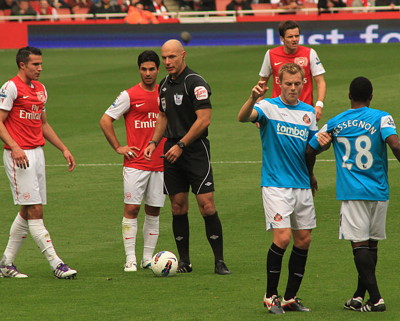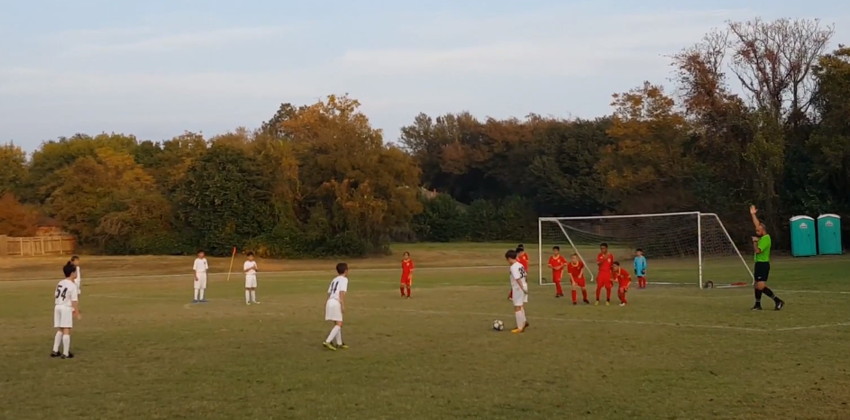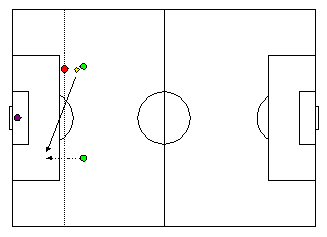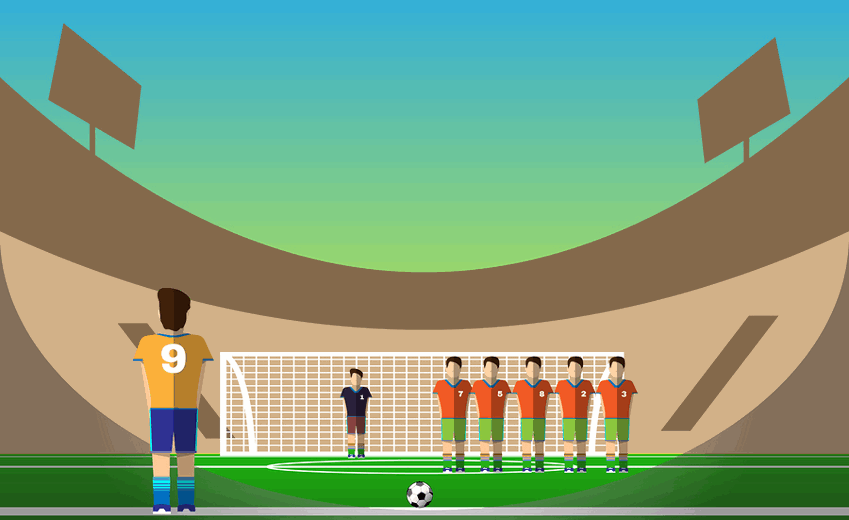
One of the most fascinating things about football is the manner in which we, as fans, will often question a referee’s decision making without really being clear on the rules ourselves. It tends to happen most often when an old rule is discarded but pundits and commentators still refer to it as being the case, so football fans listening to them assume that it’s real and continue to spout it as a law of the game.
It’s not just pundits and the like that are guilty of this, of course. Older football fans, who remember said rule, will also say it as if it’s gospel and younger supporters close to them in the ground will take it on board. Sometimes it’s not even just older rules that are now obsolete but merely things that people assume to be true and have decided are in the Laws of the Game, even if there’s no evidence to support that theory.
The point being, professional referees know a lot more about the laws that should apply to football matches than virtually any casual supporter. That’s why there are a whole host of rules and regulations that we vaguely recall hearing about at various points, but that we don’t truly know when they come into play or should be used, if we’re being totally honest with ourselves. One such rule is the indirect free-kick. When was it added to the Laws of the Game? Why did it come about? When is it applicable as a rule instead of the more common direct free-kick? It’s entirely possible that some of you don’t know what an indirect free-kick is, given that their use in the game isn’t all that common and you could legitimately have never seen one given in a position that would make you realise the importance of its having been awarded.
What Is An Indirect Free-Kick?

Let’s start with an obvious one – what exactly is an indirect free-kick? Simply put, this is a way of re-starting a football match that means the ball cannot be kicked directly into the goal.
In order for a goal to be scored from an indirect free-kick, the ball must be touched by a player from either team before it crosses the goal line.
If a goal is scored from an indirect free-kick without having gained a touch from another player then the defending team is awarded a goal kick.
What Are Indirect Free-Kicks Awarded For?

In the introduction we mentioned that you might not have seen an indirect free-kick awarded ‘in a position that would make you realise the importance of its having been awarded’. That’s because indirect free-kicks are actually awarded all of the time, but they’re in such a position on the pitch that you probably won’t have realised, given that players are unlikely to go for goal from there anyway. The most obvious and common example of such a free-kick is one awarded for an offside decision. Given that these have to be within the half of the defensive team, they’re an entire half of a football pitch away from the opposition’s goal – at least – and therefore a strike at goal would be unlikely in the extreme. You’ll know that an indirect free-kick has been awarded, incidentally, because the referee will raise his arm above his head and keep it there until the free-kick has been taken.
The reason that indirect free-kicks being awarded in other parts of the pitch is less common is that they tend to be given when a player commits an infringement of some technical aspect of the game that isn’t as obvious as a foul, handball or other breaking of the rule. The language around indirect free-kicks can also be a little bit vague, with the International Football Association Board declaring that an indirect free-kick will be awarded if a player ‘plays in a dangerous manner’, for example. What constitutes a ‘dangerous manner’ and how is that different from ‘dangerous play’? This type of re-start is also awarded if a player ‘impedes the progress of an opponent without any contact being made’, which is a difficult one for a referee to make a firm decision over.
Indirect free-kicks can be awarded if a player is guilty of dissent, which is apparently supposed to include the use of offensive language or gestures. Reading something like that, you could be forgiven for wondering why indirect free-kicks aren’t awarded every five minutes in most football matches, given some of the language used by even the top players. The indirect free-kick is something of a catch all for referees, given that one of the reasons that they can be awarded is if a player ‘commits any other offence not mentioned in the Laws’ that results in them being cautioned or sent off. Outside of offside offences, one of the most common reasons for the awarded of an indirect free-kick is when a goalkeeper either picks up a ball when it’s been deliberately passed back to him by the foot of a player on the same side (as in the graphic at the top of this section), or if a goalkeeper keeps hold of the ball for longer than the allotted six seconds.
Taking Indirect Free-Kicks

Now that we know what an indirect free-kick can be given for, let’s have a brief look at how this form of re-starting a game of football can be taken. Normally they are taken from wherever the offence that led to them being awarded was committed.
That’s not always the case, however.
Should an infraction of the rules occur inside the opposition’s penalty area then the free-kick will be taken from the ‘nearest point on the goal area line which runs parallel to the goal line’.
If an indirect free-kick is given because a player has entered or re-entered the field without the permission of the referee, then it will be taken from wherever the ball was when play was stopped. If a player has left the pitch and caused an offence then the free-kick will be taken from the boundary line that’s closest to wherever the offence was committed.
Interestingly, a penalty is never awarded for the committing of an indirect free-kick offence inside the penalty area.
The History Of The Indirect Free-Kick

Whenever you discuss the Laws of the Game, it’s important to remember that when football was in its more formative years it could best be described as something of a hybrid between the game that we know today and the game of rugby. The original Laws were drawn up by a man named Ebenezer Cobb Morley and ratified on the 8th of December in 1863. They were most closely based on the Cambridge Rules at a time when the various groups playing football around the country had their own version of how the game should be played.
When these rules were accepted by the Football Association, the game was significantly different from the one we know today to the point that if you invented a time machine and went back to those days you probably won’t know they were playing football at all. There was no crossbar, for example, and players could catch the ball. The newly formed FA’s rules weren’t adopted by every part of the country either, which is why it’s important to talk about how different the game was compared to modern day. The idea of an indirect free-kick finds its basis in the Sheffield Rules, some of which were adopted and amalgamated into the Laws of the Game in 1877.
The Sheffield Rules states that no goal could be scored from a free-kick, so you can see where the idea for an indirect free-kick came from. Sides from London and Sheffield played each other fairly regularly under both sets of rules, which is what led to the formation of one over-riding set of rules adopted by all of football. The two sets of players and officials were able to see which rules worked well and which ones didn’t, adopting and tweaking as they saw fit. The first time that the awarding of an indirect free-kick was introduced specially into the Laws of the Game was in 1874 and it was the first time that the London Rules had featured any sort of mention of a putative action coming into play for a breaking of the rules – in this case handball.
The use of the indirect free-kick was expanded to cover both offsides and foul play in 1874, which was the same year that the rules saw the introduction of a match official. At that point in time any free-kick awarded was an indirect one. That included fouls committed inside what we’d think of nowadays as being the penalty area, with that only changing with the introduction of the penalty in 1891 for foul play or handballs within twelve yards of the goal. The first time a free-kick could be used to score a goal directly was in 1903, at which point the direct free-kick could be awarded for handball or foul play. Though numerous changes to the laws occurred in the years that followed, it was that moment that changed the way that free-kicks are thought of and taken and have been ever since.
